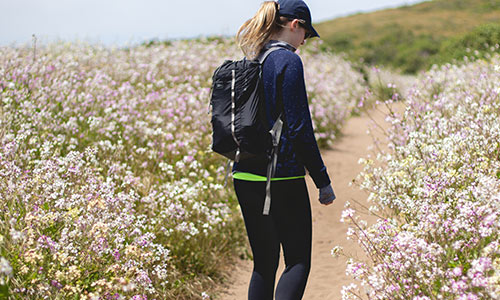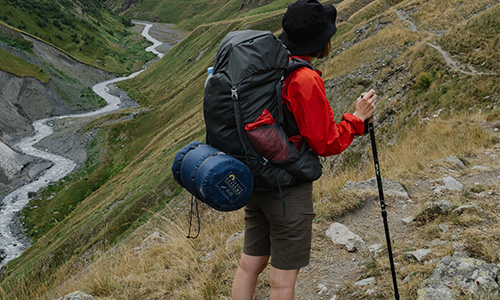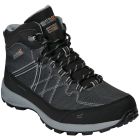Managing Swollen Feet After Hiking: Prevention and Relief Tips
Author
Hiking is an exhilarating activity that often leaves us with cherished memories and captivating stories. However, it can also bring along an unexpected souvenir: swollen feet. In this article, we will delve into the causes of swollen feet during hiking, methods to prevent it, and effective ways to soothe tired feet after a hike. While swollen feet are a common occurrence, it is crucial to be aware of potential risks and seek professional advice if necessary.
Causes of Swollen Feet During Hiking
Increased Blood Flow: During physical activities like hiking, blood flow to the heart and lungs increases to sustain the body's movement. This heightened blood flow causes blood vessels to dilate, leading to swelling in various parts of the body, commonly observed in the feet and hands.
Gravity's Influence: The force of gravity causes fluids to move downwards in the body, leading to fluid accumulation in the feet and ankles during extended periods of walking or standing. As hiking breaks are often insufficient to redistribute the fluid, swelling may persist even after the hike.
Compression from Footwear: Hiking socks and tight-fitting boots exert pressure on the soft tissues and blood vessels in the feet. Over time, this compression disrupts blood flow, contributing to swollen feet.

Monitoring Swelling
While swollen feet are normal after hiking, it is essential to monitor the extent of the swelling. If swelling persists after a few hours of rest or if only one foot is excessively swollen, it could indicate an underlying health issue or injury. In such cases, consulting a medical professional is advisable to rule out any serious concerns.
Soothing Swollen Feet After a Hike
Rest: After a long hike, the most effective remedy is to elevate your feet and take the weight off them for a while. Raising your feet can facilitate fluid redistribution and offer relief.
Loose-fitting Accessories: Ensure that any clothing or accessories you wear during the hike, including socks, shoes, and bags, are loose-fitting and comfortable to avoid impeding circulation.
Preventing Swollen Feet During a Hike
Fresh Socks: Wear fresh socks during extended hiking periods to maintain foot hygiene and alleviate pressure around the ankles and feet.
Consider Compression Socks: Compression socks can help reduce swelling by promoting proper blood circulation during the hike.
Rest Periods: During rest periods of 15 minutes or longer, take off your boots and socks to allow your feet to breathe and reduce swelling.
Keep Circulation Flowing: Wiggle your toes periodically while hiking to keep circulation active and prevent fluid from settling in the toes.
Relax Your Feet: Opt for well-fitting, broken-in hiking boots that encourage foot relaxation, preventing fluid buildup and enhancing circulation.
Adjust Boot Lacing: Avoid lacing hiking boots too tightly to prevent constriction and maintain proper blood flow.
Use Walking Poles: Utilise walking poles to reduce weight-bearing on your feet, providing support and promoting balance.

The Importance of Nutrition and Hydration
Maintaining proper nutrition and hydration is crucial to prevent foot swelling during and after a hike. Electrolyte intake can help keep salt levels stable, allowing the body to absorb water efficiently and reducing the risk of swelling. Packing low-salt foods and snacks for energy during the hike can aid in maintaining a healthy sodium balance.
Conclusion:
Swollen feet may be a common occurrence during hiking, but with the right precautions and care, they can be managed effectively. By following the preventative measures outlined in this article and staying attentive to any excessive swelling or unusual symptoms, hikers can enjoy their adventures with fewer discomforts and more cherished memories.
-
 Regatta Mens Samaris Lite Hydropel Durable Walking Boots£42.24 to £44.88RRP £120.00 Save Up To £77.76
Regatta Mens Samaris Lite Hydropel Durable Walking Boots£42.24 to £44.88RRP £120.00 Save Up To £77.76
Author
Categories
- Sport (28)
- Product Reviews (3)
- Team Outdoor Look (7)
- Mike Wild (2)
- Mike Payton (2)
- Suse Hammond-Pears (3)
- Snowboarding (12)
- Latest Offers (105)
- Shop Talk (1)
- Competitions (7)
- Walking (413)
- Lifestyle Fashion (8)
- Travel (86)
- Kit Guides (176)
- Workwear Clothing (6)
- Safety Workwear (4)
- Health/Fitness (289)
- Skiing (91)
- Great Outdoors (1316)
- Cycling (92)
- January 2025
- December 2024
- November 2024
- October 2024
- September 2024
- August 2024
- July 2024
- June 2024
- May 2024
- April 2024
- March 2024
- February 2024
- January 2024
- December 2023
- November 2023
- October 2023
- September 2023
- August 2023
- July 2023
- June 2023
- May 2023
- April 2023
- March 2023
- February 2023
- January 2023
- December 2022
- November 2022
- October 2022
- September 2022
- August 2022
- July 2022
- June 2022
- May 2022
- April 2022
- March 2022
- February 2022
- January 2022
- December 2021
- November 2021
- October 2021
- September 2021
- August 2021
- July 2021
- June 2021
- May 2021
- April 2021
- March 2021
- February 2021
- January 2021
- December 2020
- November 2020
- October 2020
- September 2020
- August 2020
- July 2020
- June 2020
- May 2020
- April 2020
- March 2020
- February 2020
- January 2020
- December 2019
- November 2019
- October 2019
- September 2019
- August 2019
- July 2019
- June 2019
- May 2019
- April 2019
- March 2019
- February 2019
- January 2019
- December 2018
- November 2018
- October 2018
- September 2018
- August 2018
- July 2018
- June 2018
- May 2018
- April 2018
- March 2018
- February 2018
- January 2018
- December 2017
- November 2017
- October 2017
- September 2017
- August 2017
- July 2017
- June 2017
- May 2017
- April 2017
- March 2017
- February 2017
- January 2017
- December 2016
- November 2016
- October 2016
- September 2016
- August 2016
- July 2016
- June 2016
- May 2016
- April 2016
- March 2016
- February 2016
- January 2016
- December 2015
- November 2015
- October 2015
- September 2015
- August 2015
- July 2015
- June 2015
- May 2015
- April 2015
- March 2015
- February 2015
- January 2015
- December 2014
- November 2014
- October 2014
- September 2014
- August 2014
- July 2014
- June 2014
- May 2014
- April 2014
- March 2014
- February 2014
- January 2014
- December 2013
- November 2013
- October 2013
- September 2013
- August 2013
- July 2013
- June 2013
- May 2013
- April 2013
- March 2013
- February 2013
- January 2013
- December 2012
- November 2012
- October 2012
- September 2012
- August 2012
- July 2012
- June 2012
- May 2012
- April 2012
- March 2012
- February 2012
- January 2012
- December 2011
- November 2011
- October 2011
- September 2011
- August 2011
- May 2010
- April 2010
- March 2010
- February 2010
- January 2010
- November 2009
- October 2009
- September 2009


Submit a Comment